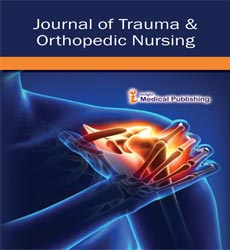The Role of Orthopaedic Nurses in Multidisciplinary Trauma Teams: Bridging Care and Communication
Rajesh Iyer*
Department of Orthopaedics and Nursing, Christian Medical College, Vellore, India
Received date: February 02, 2025, Manuscript No. ipton-25-20821; Editor assigned date: February 04, 2025, PreQC No. ipton-25-20821 (PQ); Reviewed date: February 15, 2025, QC No. ipton-25-20821; Revised date: February 20, 2025, Manuscript No. ipton-25-20821 (R); Published date: February 27, 2025, DOI: 10.36648/ipton.8.1.112
Citation: Iyer R (2025) The Role of Orthopaedic Nurses in Multidisciplinary Trauma Teams: Bridging Care and Communication. J Trauma Orth Nurs Vol.8 No.1: 112.
Introduction
Trauma care is inherently complex, often requiring the expertise of a multidisciplinary team to address acute injuries, stabilize patients, and support long-term recovery. Within this team, orthopaedic nurses play a pivotal role in managing musculoskeletal injuries, providing holistic care, and facilitating communication across disciplines. Their contributions extend beyond bedside management, encompassing patient advocacy, education, and coordination of care. This article explores the vital role of orthopaedic nurses in multidisciplinary trauma teams, emphasizing how they bridge care and communication to improve outcomes. Orthopaedic nurses possess specialized knowledge in musculoskeletal anatomy, fracture management, wound care, and postoperative rehabilitation. This expertise allows them to provide accurate assessments and implement tailored interventions for trauma patients. Whether managing external fixation devices, monitoring neurovascular status, or preventing complications such as compartment syndrome, their role is indispensable in ensuring timely and effective care [1].
Description
In the acute phase of trauma, orthopaedic nurses contribute to the stabilization process by assisting with resuscitation, monitoring vital signs, and preparing patients for surgical interventions. They ensure that fracture stabilization techniques, such as splinting and traction, are performed promptly and safely. Their ability to quickly identify changes in a patientâ??s condition supports the trauma team in making rapid, evidence-based decisions. Effective pain management is a priority in orthopaedic trauma care, as untreated pain can hinder recovery and impair mobility. Orthopaedic nurses assess pain levels using standardized scales, administer analgesics, and employ non-pharmacological methods such as positioning and cold therapy. They also monitor the effectiveness of interventions, ensuring individualized pain control strategies that enhance both physical and psychological comfort. Trauma patients with orthopaedic injuries face risks such as infection, deep vein thrombosis, and impaired mobility [2].
Orthopaedic nurses play a central role in complication prevention by maintaining strict aseptic techniques, implementing anticoagulation protocols, and encouraging early mobilization when appropriate. Vigilant monitoring and proactive interventions help mitigate risks, reducing morbidity and improving survival rates. Recovery from orthopaedic trauma extends far beyond surgical repair. Nurses guide patients through rehabilitation by promoting mobility, encouraging adherence to physiotherapy, and teaching safe use of assistive devices. Their ongoing support fosters functional independence and reduces long-term disability. By collaborating closely with rehabilitation specialists, they ensure continuity of care throughout the recovery journey [3].
Orthopaedic trauma often results in significant lifestyle adjustments. Nurses serve as educators, providing patients and families with knowledge about wound care, weight-bearing restrictions, and signs of complications. By empowering patients and caregivers with practical skills, they promote adherence to treatment plans and facilitate smoother transitions from hospital to home care [4].
The psychological impact of traumaâ??ranging from anxiety to post-traumatic stressâ??requires compassionate nursing intervention. Orthopaedic nurses provide emotional support through therapeutic communication and patient advocacy. They help patients navigate fears about surgery, rehabilitation, and long-term disability. This advocacy ensures that patient voices are heard in multidisciplinary discussions, aligning care with individual needs and preferences. Orthopaedic nurses act as vital links between surgeons, anesthesiologists, physiotherapists, occupational therapists, and social workers. Their position at the bedside enables them to synthesize observations and communicate critical updates to the broader team. Through effective coordination, they enhance the flow of information, prevent miscommunication, and ensure a seamless continuum of care. Many healthcare institutions adopt standardized trauma protocols such as Advanced Trauma Life Support (ATLS) or local clinical guidelines care [5].
Conclusion
Orthopaedic nurses are indispensable members of multidisciplinary trauma teams, bridging the gap between direct patient care and interprofessional collaboration. Their specialized expertise, advocacy, and communication skills ensure that musculoskeletal trauma patients receive comprehensive, coordinated, and compassionate care. By supporting early stabilization, preventing complications, facilitating rehabilitation, and fostering collaboration, orthopaedic nurses enhance patient outcomes and quality of life. As trauma care continues to evolve, their role in bridging care and communication will remain critical to advancing excellence in practice.
Acknowledgement
None.
Conflict of Interest
None.
References
- Reis H, Eusébio I, Sousa M, Ferreira M, Pereira R, et al. (2021). Regul-a: A technological application for sensory regulation of children with autism spectrum disorder in the home context. Int J Environ Res Public Health18: 10452.
Google Scholar Cross Ref Indexed at
- Su WC, Srinivasan S, Cleffi C, Bhat, A. (2021). Short report on research trends during the COVID-19 pandemic and use of telehealth interventions and remote brain research in children with autism spectrum disorder. Autism25: 1816-1822.
Google Scholar Cross Ref Indexed at
- Ferguson EF, Jimenez-Muñoz M, Feerst H, Vernon TW. (2022). Predictors of satisfaction with autism treatment services during COVID-19. J Autism Dev Disord52: 3686-3697.
Google Scholar Cross Ref Indexed at
- Miltenberger CA, Charlop MH. (2014). Increasing the athletic group play of children with autism. J Autism Dev Disord44: 41-54.
Google Scholar Cross Ref Indexed at
- Lima JL, Axt G, Teixeira DS, Monteiro D, Cid L, et al. (2020). Exergames for children and adolescents with autism spectrum disorder: an overview. Clin Pract Epidemiol Ment Health16: 1.
Open Access Journals
- Aquaculture & Veterinary Science
- Chemistry & Chemical Sciences
- Clinical Sciences
- Engineering
- General Science
- Genetics & Molecular Biology
- Health Care & Nursing
- Immunology & Microbiology
- Materials Science
- Mathematics & Physics
- Medical Sciences
- Neurology & Psychiatry
- Oncology & Cancer Science
- Pharmaceutical Sciences
